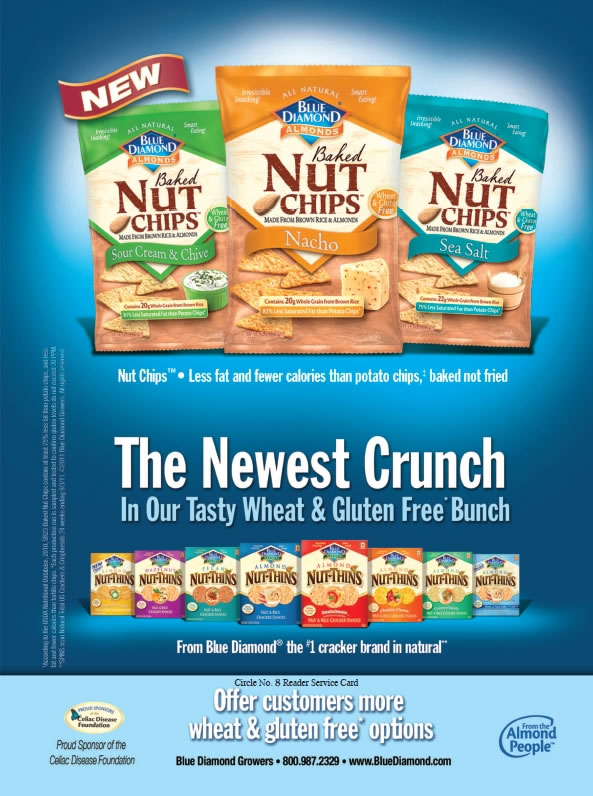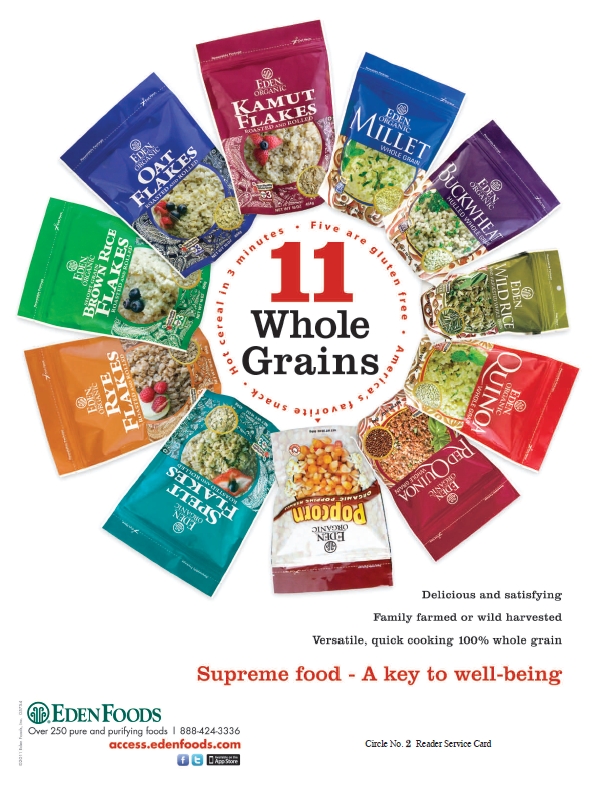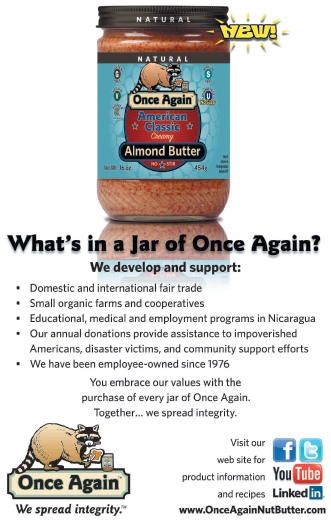About 12 million Americans have food allergies (1). That’s roughly the populations of New York City and Los Angeles combined. Throw in the number of Americans with intolerances to gluten (at least three million) and lactose (40–50 million), and we’d more than quadruple that number (2, 3).
Given these statistics, it’s likely that an overwhelmingly large percentage of your shoppers are looking for a “-free” lunch—especially foods that are devoid of nuts, gluten, lactose, eggs and more.
Fine-Tuning Gluten-Free
Defining “gluten-free.” Gluten-free food shopping can be a guessing game since the verbiage on such foods may not be 100% clear. "The U.S. absolutely needs a definition of 'gluten free,'" says Kimberlee Ullner, Founder & President, 1-2-3 Gluten Free, Inc. "Currently, without a government-recognized definition, 'gluten-free' can mean different things to different people. From a consumer-standpoint, to have a definition in place that is consistent with medical research, means any company putting 'gluten free' on its product labels will also be consistent with the medically-accepted standard. Without the government-sanctioned definition, theoretically, someone can label a product as gluten-free that is not really gluten free."
On August 2, the U.S. Food and Drug Administration (FDA) said it will address this problem by re-examining the labeling requirements for gluten-free foods. The agency reopened the comment period for its proposed gluten-free labeling rule originally made public in January 2007. At that time, analytical techniques couldn’t accurately determine whether very small amounts of gluten were present in foods, but science has now advanced to the point that we may have a clearer picture of the situation. The potential outcome? Stricter labeling and tighter standards.
“Gluten-free,” according to FDA, would mean the absence of:
• an ingredient that is a species of wheat, rye, barley or a crossbred hybrid of these grains;
• an ingredient derived from these grains and that has not been processed to remove gluten;
• an ingredient derived from these grains and that has been processed to remove gluten, if the use of that ingredient results in the presence of 20 or more parts per million (ppm) gluten in the food; or
• 20 ppm or more gluten (4).
Some industry members feel that this definition stacks up, while others see holes in it. “Glutino applauds FDA for its movement forward on this issue,” says Terence Dalton, general manager of Glutino, Laval, QC, Canada. “With so much growth in the gluten-free industry, labeling regulations need to be clearly defined and consistent for all manufacturers in the category, and we appreciate the FDA’s attention to this issue.”
In agreement is Stephanie Robbins, director of marketing for Pamela’s Products, Ukiah, CA. She states, “Consumers have a right to know what [gluten free] means and that companies making these claims are producing under proper standards and guidelines.”
The industry support for FDA’s definition seems to be two-fold. First, it creates a level playing field for companies. A standard definition, says Jerry Colburn, national sales and marketing manager at Ener-G Foods, Seattle, WA, would “provide a benchmark for manufacturers to follow.”
This is important because some manufacturers have been untruthful with their gluten-free offerings, and this has lead to problems for shoppers trying to avoid gluten. Says Jerry Bigam, president of Kinnikinnick Foods Inc. Edmonton, AB, Canada, “Our experience over the past 20 years indicates that without tight standards, so-called ‘gluten-free’ foods can get into the market and cause significant health problems.”
What’s a consumer to make of all this? As more and more gluten-free products enter the market, Daniel Wiser, director of marketing at Attune Foods Inc., San Francisco, CA, has found unanswered questions in shoppers’  minds. “Is it a dedicated facility? Is it on a shared line? What is the cross-contamination prevention program of the company? What a clear definition from the FDA would provide are boundaries to keep people with celiac disease and gluten intolerance safe,” he says.
minds. “Is it a dedicated facility? Is it on a shared line? What is the cross-contamination prevention program of the company? What a clear definition from the FDA would provide are boundaries to keep people with celiac disease and gluten intolerance safe,” he says.
But, many feel there’s still some room for improvement with FDA’s definition. The first problem is with the 20 ppm standard. This number was developed based on research on celiac disease patients. Dalton believes such a level is sufficient, since research indicates celiac patients ingesting this amount of gluten or less won’t experience problems (5). Meanwhile, certifying agent, Gluten-Free Certification Organization uses 10 ppm as its upper limit, and will continue to use this number as its standard, even if it’s stricter than FDA’s policy.
Add Ullner, "The proposed definition of gluten free, less than 20 PPM, is supported by science--by physicians and researchers who specialize in celiac disease. For the vast majority of those with celiac disease, foods that are within these levels are safe. Further, this definition is consistent with the definition utilized in other countries. I support the current proposal. 1-2-3 Gluten Free products all test below 5 PPM so when the FDA releases this as its definition, as a company, we don’t need to make any changes."
Cynthia Kupper, RD, CD, executive director of Gluten Intolerance Group (GIG), Auburn, WA, adds a complicating factor to the mix: 20 ppm does not factor in people that have gluten sensitivities besides celiac disease. “What we don’t know is whether these people are more or less sensitive than those with celiac disease,” she states, questioning whether the definition needs to be redesigned with these folks in mind. “The whole area of gluten sensitivity that is not celiac disease is fairly new, and there has not been a lot of research done about it…we don’t know the impact of gluten on their bodies except that gluten sensitivity seems to be a lot like lactose intolerance.”
Kupper says that if FDA allows for the definition to stand at 20 ppm, she hopes it will agree to periodically review new research on which levels set off those with gluten sensitivities other than celiac disease to see if adjustments need to be made.
Another issue comes from Colburn, who wishes the definition would not remain silent about problematic ingredients like oats. Some evidence suggests that some celiacs are affected by the proteins in oats and should limit their intake of oats. Part of the reason is that while oats, themselves, do not contain gluten, they are often contaminated with gluten during growing and processing. Thus, many  celiac sufferers play it safe by avoiding oats. It should be noted that some companies are starting a new trend: offering gluten-free oats. For instance, Bakery on Main is rolling out a line of gluten-free instant oatmeals while HomeFree is offering organic allergen-free treats like certified gluten-free cookies made with gluten-free oat flour.
celiac sufferers play it safe by avoiding oats. It should be noted that some companies are starting a new trend: offering gluten-free oats. For instance, Bakery on Main is rolling out a line of gluten-free instant oatmeals while HomeFree is offering organic allergen-free treats like certified gluten-free cookies made with gluten-free oat flour.
As for other “gluten-removed” items, Bigam feels “it will have to be an individual judgment to determine if the processing is consistent and reliable.”
Another intrinsic problem with the definition, according to Don Stinchcomb, president of Purity Foods, Inc., Okemos, MI, is that it doesn’t explicitly require foods to be prepared in a dedicated gluten-free facility. Gluten can spread easily, so unless a plant is dedicated as gluten-free, cross-contamination can occur. Even having just a dedicated line within a gluten-processing facility can pose a problem, depending on the set-up.
This cross-contamination issue is definitely on the radars of celiac disease patients. “It is my understanding that factions of the celiac community will only accept products made in a dedicated gluten-free facility,” Stinchcomb states. “It would be nonsensical to have the FDA forge a definition that may be detrimental to the celiac if the parameters were not strict enough.”
Wiser agrees that FDA should offer more criteria for the actual production of gluten-free foods. “It might help to define some clear processes that gluten-free products must adhere to,” he states. “Defining process will help reinforce the gluten content limits established in the standard.”
But while some feel that having a gluten-free plant is the only way for a food to be truly gluten-free, others disagree. Regarding this, Wiser states, “While it’s true that the presence of gluten in a common manufacturing plant can create cross contamination issues, it’s the process of how the plant segregates ingredients and cleans the lines that determines the possibility of gluten in a finished product.”
Getting it straight. Like many popular diets, gluten-free foods suffer from consumers’ misconceptions.
Not well-known is that some people have wheat intolerances and allergies that are unrelated to gluten. For these people, spelt may be an appropriate substitute. According to Stinchcomb, spelt, einkorn and emmer are part of the Triticum genus and each had its own species derivation. These grains were  predecessors to wheat. He states that FDA chose to use the collective noun, “wheat,” to describe everything in the Triticum genus, which made grains like spelt become “wheat” even though they are genetically different. “When we appealed their decision, the FDA found only one case in about 20 years where there was any link to an allergic reaction to spelt. It was related to an exercise-induced allergic reaction, which is not considered a true food allergy,” says Stinchcomb.
predecessors to wheat. He states that FDA chose to use the collective noun, “wheat,” to describe everything in the Triticum genus, which made grains like spelt become “wheat” even though they are genetically different. “When we appealed their decision, the FDA found only one case in about 20 years where there was any link to an allergic reaction to spelt. It was related to an exercise-induced allergic reaction, which is not considered a true food allergy,” says Stinchcomb.
Another area where we need more education is that gluten-free foods may not be healthier choices for the average person without a gluten intolerance. The reason why is that gluten-containing grains often are enriched with vitamins, and those avoiding them may be missing nutrients.
"For those who do not have celiac disease, wheat allergies or gluten sensitivities," says Ullner, "there is no evidence that eating something that is gluten free has any additional health benefits over gluten alternatives. In fact, many gluten-free foods are not enriched with vitamins/minerals, while most gluten-containing foods are."
But, Bigam says manufacturers have done a lot to work on their foods’ nutritional profiles. He states, “Gluten-free foods have been criticized for being low in fiber, high in calories and lots of empty carbs. That was the case a few years ago, but most gluten-free manufacturers are making considerable efforts to improve the nutritional profile of their products.”
This is one reason why 1-2-3 Gluten Free released a fortified gluten-free flour mix.
Next, Kupper raises the point that shoppers don’t understand parts per million. “They don’t understand that 20 is safe,” she states. “They are stuck in the idea that ‘free’ should be zero…they’re confused.” It’s impossible to measure to zero with today’s technology, but shoppers probably have never heard that the testing assays are unreliable at that level. In essence, gluten-free shoppers just want the strictest standards possible, so retailers can help them understand what “gluten-free” truly means and the value of third-party certification.
Another fallacy is that gluten-free food is not as good as the wheat alternatives in flavor, texture and quality ingredients, says Robbins. “This simply is not true, but not all products are created equally,” she states. She notes that her company’s mixes can make delicious pancakes, waffles, cakes, cookies, scones and more. “We now know that many of the people who purchase our Pamela’s Baking & Pancake Mix are not on a gluten-free diet; they simply love the product. That’s an item that is blowing holes in the misconception that gluten-free foods are not as good,” Robbins says.
Thus, like many aspects of healthy living, education is needed, and retailers can play a big part. Dalton says his company “has collaborated with several retailers to create educational materials, and host special events to educate consumers on gluten-free products and how to live the gluten-free lifestyle. We’ve also developed an educational pamphlet that provides information and support for those newly diagnosed with celiac disease.”
Upsurge in Food Allergies
If you’ve seen a steady increase in shoppers looking for foods free of allergens like nuts and eggs, you’re not alone. Food allergens have become more and more prevalent; from 1997 to 2007, the number of reported food allergies in children increased 18% (6).
There are some working theories out there for explaining this increase. First, Bigam says that more awareness about food allergens among consumers and their physicians has brought on more diagnoses of conditions that were always prevalent.
Others believe man-made environmental factors are to blame. Says Colburn, “I feel that the increase in allergens and allergic reactions in the general population is due to the increased contamination of our air, water, food and soils from toxins and chemical byproducts of our industrial society.” Another similar factor, says Stinchcomb, could be the tampering with natural crop species. “Man’s continuing effort to change what nature has given us without the knowledge or the perception to know and recognize the extent of each change…If hybridization has contributed to our increase in allergies, imagine what GMOs have the potential to do.”
Another theory comes from Dan Hofland, vice president of marketing for SunButter, Fargo, ND. He says our obsession with cleaning and sanitizing may have lead to increased allergies. Wiser adds his two cents about the hygiene hypothesis: “Our bodies have been unable to build up immunities to substances that morph into allergies. Whether true or not, and regardless of the cause, there is a need for products that offer nutritional solutions.”
|
Select Category Offerings Offerings of companies interviewed for this article. 1-2-3 Gluten Free: Olivia’s Outstanding Multi-purpose Flour Mix plus other gluten-free, allergen-free baking mixes. Attune Foods Inc.: Erewhon Organic and Gluten Free Cereals in seven varieties; Attune Chocolate Probiotic Bars; New Morning Organic Graham Crackers. HomeFree: Allergen-free cookies, gluten-free cookies, allergen-free coffee cake and allergen-free baking ingredients. Kinnikinnick: Breads, buns, bagels, cookies, mixes, pizza crusts, pie crusts, waffles, donuts, muffins, brownies and cinnamon buns manufactured in a dedicated gluten-free, dairy-free, tree nut-free and peanut-free facility. SunButter: SunButter sunflower seed spread. Ener-G Foods: Over 120 different wheat-free, gluten-free, dairy-free, nut-free, soy-free and kosher certified products. Glutino: More than 80 gluten-free products, which include snacks, frozen bakery items, frozen meals, baking mixes and more. Pamela’s Products: Whenever Bars, Pamela’s Baking & Pancake Mix, Pamela’s Chocolate Cake Mix, plus ready to eat cookies, biscotti, cakes and more. Purity Foods: Spelt products like VitaSpelt pastas. |
Fantastic Foods for Families
Loving school lunches. Part of the solution to which Wiser alludes is offering great, nutritious foods that are free of the most common allergens. One of the greatest challenges in this market is formulating food for children. States Hofland, “It’s very difficult for parents to be reassured that their allergic child—especially very young children—will be safe at school.”
But, finding suitable options for school lunches isn’t always easy. Hofland feels this problem is on the minds of some allergen-free food makers, especially those that specialize in peanut-free alternatives. After all, deaths from food-induced anaphylaxis most often result from exposure to peanuts (50–62%) and tree nuts (15–30%) (7). “The manufacture of a peanut-free food needs to begin at the farm level and follow all the way to the finished product,” says Hofland. “Peanut allergy sufferers depend on food that is prepared by companies that are absolutely committed and dedicated to keeping their entire facility completely peanut free.”
Since trading will inevitably happen in cafeterias, parents can take two techniques: first, give kids delicious healthy options they enjoy eating. “Our approach is to provide food that is as ‘allergy friendly’ as possible and make it as tasty as possible so that children do not feel that they have to eat ‘special medical’ food,” states Bigam.
Adds Colburn, “Kids who are on restricted diets need to have a wide variety of choices in what they can eat…Kids on restricted diets do want to have as many different options as kids without allergies.”
Second, educate children about what they should avoid if they have certain allergies and why. Says Dalton, “Making sure children are educated and aware of what foods they can and cannot eat will help mitigate issues with school lunches, play dates, etc. that might involve gluten-containing foods.”
Again, creative retailers can help here by holding a workshop about children and food allergies.
Category Expansions
As the prevalence of food allergies grows, so too do the category offerings. Says Colburn, “The allergen free category is limited only by the imagination of those companies providing foods. The old saying ‘necessity is the mother of invention’ definitely comes to mind.”
The following are some areas in which we could see even more expansion.
Baking at home. In addition to offering foods to send outside the home via brown bag, companies are responding to families’ needs to cook and bake at home. “Cooking and baking at home is optimal for people with gluten sensitivities or celiac disease because it enables them to have control over their food by knowing exactly what ingredients are being used and how the dish is being prepared,” says Dalton.
In response, Colburn says there’s been a slew of allergen-free cooking/baking ingredients and mixes come to market.
Allergen-/gluten-free crossover. Perhaps two “-frees” are better than one. Companies like Kinnikinnick Foods once only eliminated gluten from their foods, but then took out the dairy. Then, it was tree nuts, peanuts and soy in most foods. Sesame seeds will be the next allergen to say good bye. Products like these help serve a broad range of clients, plus those unfortunate individuals with multiple food allergies.
Fortified foods. Some companies are attempting to stretch the nutritional boundaries of the category with fortified products. Such products make sense because all shoppers are looking for great nutrition. Plus, customers with certain allergies and intolerances may be prone to malnutrition (like those with celiac disease). According to Dalton, Glutino just launched its Sensible Beginnings Cereals, which are fortified with 10 vitamins and minerals including vitamin C, B12 and iron. The company also recently added more fiber to its line of breakfast bars.
And at Pamela’s Products, Whenever Bars snack bars are rich in antioxidants, and include whole grains and chia seeds for texture, taste and omega-3 essential fatty acids.
Certifications. Manufacturers in this category are also certifying foods. For instance, Wiser of Attune Foods says his company has products that are verified by the Non-GMO Project, and others are certified gluten free by the Gluten Intolerance Group (GIG). “These certifications, along with our organic and whole grain certifications help add credence to our cause of providing healthier food choices that help you feel better from the inside out,” he states.
Other companies feel that certification isn’t as important as setting up the proper network to make a food appropriate for those with sensitivities. For instance, Ener-G Foods’ facilities are dedicated gluten-free, wheat-free, dairy-free, nut-free and soy-free. Purity Foods has a facility dedicated to the storage and production of spelt. And, Kinnikinnick Foods developed a gluten-free supply chain. Adds Bigam, “We have our own lab facilities and every incoming shipment of ingredients is tested for gluten down to 3 ppm. Most certification standards only spot check; our lab checks shipments every day.“ WF
Additional comments on this article are posted here.
References
1. The Food Allergy & Anaphylaxis Network, “Food Allergy Facts and Statistics,” www.foodallergy.org/downloads/FoodAllergyFactsandStatistics.pdf, accessed Sept. 27, 2011.
2. Celiac.com, “Celiac Disease Statistics,” www.celiac.com/articles/1164/1/Celiac-Disease-Statistics/Page1.html, accessed Sept. 27, 2011.
3. National Institutes of Health, “Lactose Intolerance: Information for Healthcare Providers,” www.nichd.nih.gov/publications/pubs/upload/NICHD_MM_Lactose_FS.pdf, accessed Sept. 27, 2011.
4. U.S. Food and Drug Administration, www.fda.gov/Food/LabelingNutrition/FoodLabelingGuidanceRegulatoryInformation/Topic-SpecificLabelingInformation/ucm265309.htm, accessed Sept. 27, 2011.
5. C. Catassi, et al., “A prospective, Double-Blind, Placebo-Controlled Trial to Establish a Safe Gluten Threshold for Patients with Celiac Disease,” Am. J. Clin. Nutr. 85: 160–166 (2007).
6. Centers for Disease Control and Prevention, “Food Allergy Among U.S. Children: Trends in Prevalence and Hospitalizations,” www.cdc.gov/nchs/data/databriefs/db10.htm, accessed Sept. 27, 2011.
7. American Academy of Allergies, Asthma and Immunology, “Allergy Statistics,” www.aaaai.org/about-the-aaaai/newsroom/allergy-statistics.aspx, accessed Sept. 27, 2011.
Published in WholeFoods Magazine, November 2011











